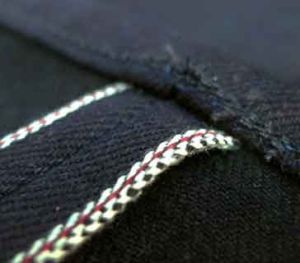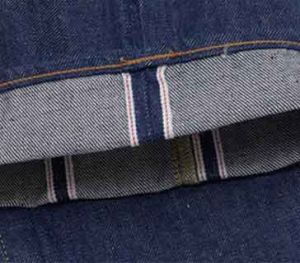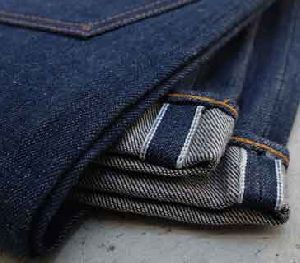
Yarn Hank Dyeing jeans
Hank dyeing essentially means the yarns are dipped and dyed manually by hand, and it's quite different to "rope dying" which is how most indigo yarns are coloured. Hank dying takes a lot of care, attention to detail, and human involvement - but it inevitably produces more irregularities which we love. The technique is simple but time-consuming. Bundles of yarn, known as ‘skeins,’ are first rinsed to open the fibres. Then, the skeins are dipped in the dyeing vat, usually numerous times. Next, they’re washed and then dipped again. The process is repeated until the desired colour intensity is achieved. At this point, the yarn is steamed to fix the dye.
...more
Raw Jeans
Over time, dry denim will usually fade, which is considered desirable by some people. During the process of wear, fading will usually occur on those parts of the article that receive the most stress. On a pair of jeans, this includes the upper thighs, the ankles, and the areas behind the knees. Patterns of fading in jeans, caused by prolonged periods of wearing them without washing, have become the main allure of dry denim. Such patterns are a way of "personalizing" the garment Selvedge denim refers to a unique type of selvedge that is made by means of using one continuous cross-yarn (the weft), which is passed back and forth through the vertical warp beams. This is traditionally finished at both edges with a contrasting warp (most commonly red); that is why this type of denim is sometimes referred to as "red selvedge." This method of weaving the selvage is possible only when using a shuttle loom.
...more
Organic Jeans
Cotton covers 2.5% of the world's cultivated land yet uses 16% of the world's insecticides, more than any other single major crop. Other environmental consequences of the elevated use of chemicals in the non organic cotton growing methods consist of High levels of agrochemicals are used in the production of non-organic, conventional cotton. Cotton production uses more chemicals per unit area than any other crop and accounts in total for 10-16% of the world's pesticides (including herbicides, insecticides, and defoliants).Chemicals used in the processing of cotton pollute the air and surface waters. Decreased biodiversity and shifting equilibrium of ecosystems due to the use of pesticides
...more
Echo-Friendly Jeans
Sustainable fashion, also called eco fashion, is a part of the growing design philosophy and trend of sustainability, the goal of which is to create a system which can be supported indefinitely in terms of human impact on the environment and social responsibility. It can be seen as an alternative trend against fast fashion. There are many factors when considering the sustainability of a material. The renewability and source of a fiber, the process of how a raw fiber is turned into a textile, the working conditions of the people producing the materials, and the material's total carbon footprint. Natural fibers are fibers which are found in nature and are not petroleum-based. Natural fibers can be categorized into two main groups, cellulose or plant fiber and protein or animal fiber. Cellulose fibers: cotton, jute, flax, hemp, ramie, abaca, bamboo (used for viscose), soy, corn, banana, pineapple, beechwood (used for rayon). Natural protein fibers: wool, silk, angora, camel, alpaca, llama, vicuna, cashmere, and mohair. Recycled or reclaimed fibers are made from scraps of fabrics collected from clothing factories, which are processed back into short fibers for spinning into a new yarn. There are only a few facilities globally that are able to process the clippings. Variations range from a blend of recycled cotton fibers with added RePET yarns for strength to recycled cotton fibers with virgin acrylic fibers which are added for color consistency and strength.
...more
denim Shirts
Denim is a sturdy cotton warp-faced textile in which the weft passes under two or more warp threads. This twill weaving produces a diagonal ribbing that distinguishes it from cotton duck. The most common denim is indigo denim, in which the warp thread is dyed, while the weft thread is left white. As a result of the warp-faced twill weaving, one side of the textile is dominated by the blue warp threads and the other side is dominated by the white weft threads. This causes blue jeans to be white on the inside. The indigo dyeing process, in which the core of the warp threads remains white, creates denim's signature fading characteristics. Selvedge Denim Shirts in India.
...more
Denim Fabric Weaving Jeans
The most common denim is indigo denim, in which the warp thread is dyed, while the weft thread is left white. As a result of the warp-faced twill weaving, one side of the textile is dominated by the blue warp threads and the other side is dominated by the white weft threads. This causes blue jeans to be white on the inside. The indigo dyeing process, in which the core of the warp threads remains white, creates denim's signature fading characteristics. We can supply any types of denim fabric from 10-16OZ in basic,slub,cross& hatch,rigid,denim and stretch too,premium and high quality in 100% cotton as well as polyester and stretch denim fabric.We will supply this prodouct in bulk quantity only.
...more
denim fabric jeans
The word ‘selvedge’ relates to the ‘self-edge’ of fabric. Selvedge is woven so the fabric’s ‘edge’ can be used in garment construction. In regards to jean construction, using the outer edge of the denim (the self-edge), makes a jean a ‘selvedge’ denim jean. . Selvedge denim is woven using old-fashioned denim-weaving techniques; most authentically woven on old looms. Selvedge looms were popular in denim weaving until the mid-to-late 1900’s. The word selvedge comes from “self-edge.” The edge of the denim has a clean finish, since it will not unravel, the edge of the fabric is used as the garment’s outseam. Therefore, looking at the inside of the outseam, is an easy way to identify a pair of jeans made from selvedge denim.
...more
cotton twill dust sheet
Ideal for protecting furniture, flooring and carpets from dust, dirt and splashes while painting and decorating projects. 100% Natural cotton and not water proof.Reusable and durable, Suitable for home based or industrial applications. Light to Medium Duty Industrial Machine Washable - Please do NOT wash in Domestic Washing Machine as once wet the weight of the sheets becomes to heavy Environment friendly. An affordable, yet efficient method to protect furniture, carpets and flooring from dust, dirt and splashes during decoration projects. The dust sheet can be re-used multiple times. Our Cotton Twill dust sheets are a standard grade of sheet, with a traditional woven construction. Widely used for covering furniture and floors, this is our most popular dust sheet and is widely used by Builders and Decorators. The sheets are re-usable, and come in a cream/off-white colour.
...more
Cotton Selvedge Denim Jeans
Over time, dry denim will usually fade, which is considered desirable by some people. During the process of wear, fading will usually occur on those parts of the article that receive the most stress. On a pair of jeans, this includes the upper thighs, the ankles, and the areas behind the knees. Patterns of fading in jeans, caused by prolonged periods of wearing them without washing, have become the main allure of dry denim. Such patterns are a way of "personalizing" the garment Selvedge denim refers to a unique type of selvedge that is made by means of using one continuous cross-yarn (the weft), which is passed back and forth through the vertical warp beams. This is traditionally finished at both edges with a contrasting warp (most commonly red); that is why this type of denim is sometimes referred to as "red selvedge." This method of weaving the selvage is possible only when using a shuttle loom.
...more
bamboo jeans
Bamboo Jeans fabric is a natural textile made from the pulp of the bamboo grass, the bamboo fiber is then made by pulping the bamboo grass until it separates into thin threads of fiber, which is then spun and dyed for weaving into cloth.. Bamboo Denim fabric is similar to the softness of silk. Since the fibers are without chemical treatment, they are naturally smoother and rounder with no sharp spurs to irritate the skin, making bamboo fabric hypoallergenic and perfect for those who experience allergic reactions to other natural fibers such as wool or hemp. On that same note, bamboo is also antibacterial and antifungal. This is because bamboo possesses an anti-bacteria and bacteriostatic bio-agent called "Bamboo Kun", allowing it to naturally flourish and grow in the wild without the use of pesticides or fertilizers. This beneficial quality of the plant remains in its textile form, killing all bacteria keeping the wearer feeling fresher and odor free for longer, making the garment healthier and more hygienic
...moreBe first to Rate
Rate ThisOpening Hours